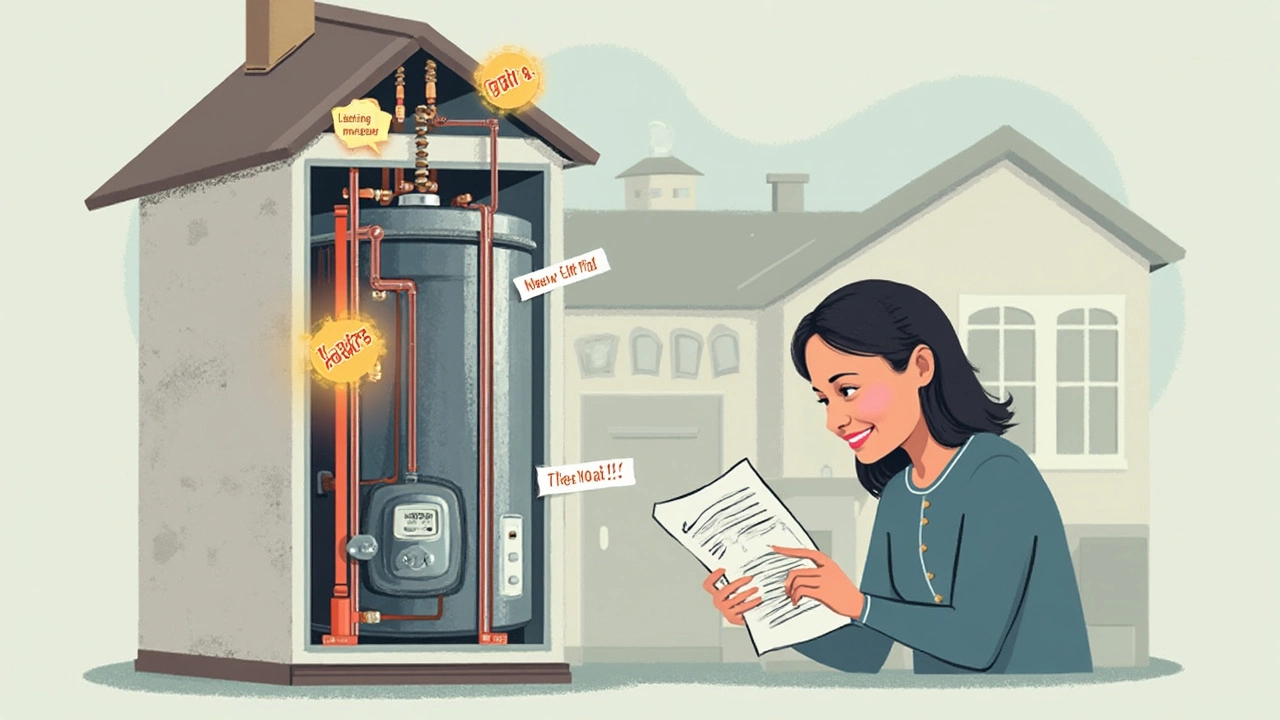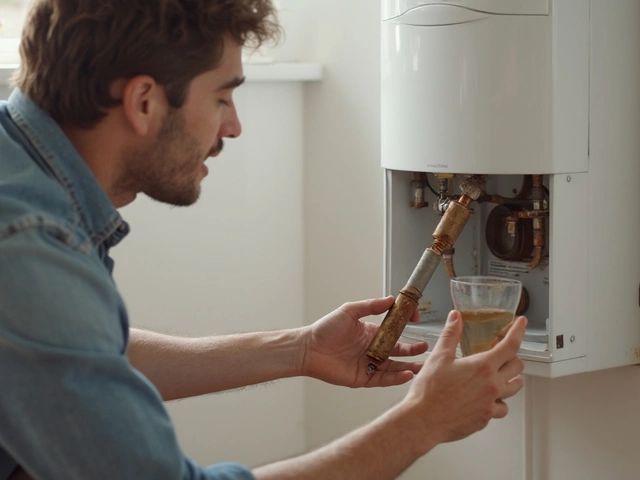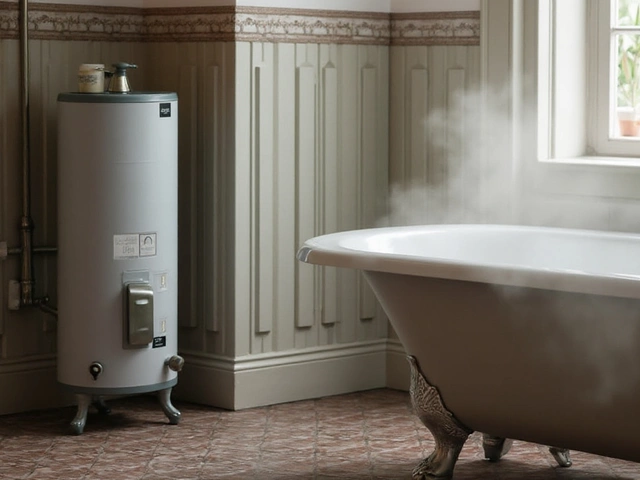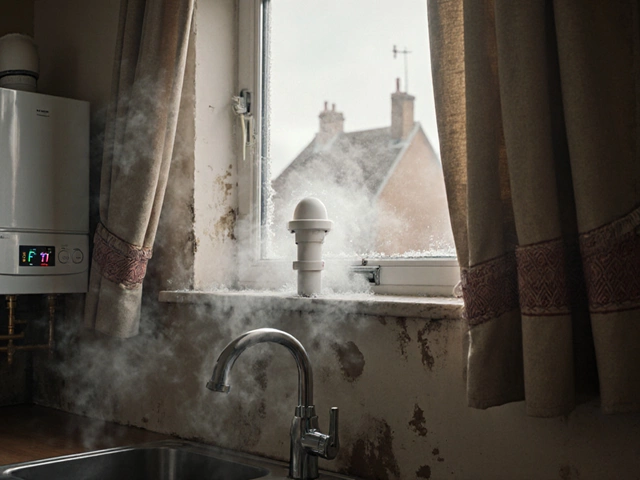The moment you turn the shower on and get hit with an icy blast, you know something’s up with your water heater. Here’s the wild part—most people skip checking the simple stuff first and end up freezing while they wait for help. Sometimes, fixing the cold water problem is easier than you think.
If your water heater is only spitting out cold water, start by making sure it’s actually getting power. Electrical heaters can trip a breaker or blow a fuse and gas heaters might not even have gas reaching the pilot. Seriously, you’d be surprised how many water heater "failures" are just silent switches or pilot lights that went out without warning.
Get a flashlight and take a look at the water heater’s indicator light or control panel. No lights? No sound? You could just have a power or gas supply issue, which is a quick fix if you know where your breaker panel or gas shutoff is. If everything’s on, but you’re still cold—don’t worry—there’s more you can check before calling in the cavalry.
- Check the Power (or Gas Supply)
- Thermostat Problems
- Heating Element or Burner Issues
- Pilot Light and Ignition Failures
- Sediment Buildup and Tank Troubles
- What to Try Before Calling a Plumber
Check the Power (or Gas Supply)
This is where a lot of water heater headaches begin. You can’t get hot water if your water heater isn’t even getting energy, right? Start simple and check if the unit’s actually powered. For electric models, find your home’s breaker box. Look for a switch labeled "water heater." If it’s flipped off or in the middle, snap it firmly to "off," wait a few seconds, then switch it back to "on." Electric heaters also sometimes have their own fuse or safety switch right next to the tank—give that a look too.
For gas water heaters, the deal is a little different. Make sure the gas valve is in the "on" position—sometimes it gets bumped accidentally. If you see or smell gas around the tank, though, stop right there and call your utility company—don’t try to fix a gas leak yourself.
You can actually spot a pattern here. In a study from the National Association of Home Builders, power supply failures were called out as one of the top three causes of no hot water complaints. It’s surprisingly common!
- Check the breaker (electric) or gas valve (gas models).
- Look for blown fuses near the water heater unit.
- For gas heaters, check if the pilot light is lit—no flame means no hot water.
- Listen for any humming or clicking from the tank. If it’s totally silent, that’s a clue there’s no power or gas.
One last thing: most newer heaters have a reset button, usually a small red one on the control panel. If your heater has power but isn’t heating, try pressing that and waiting 15 minutes. Sometimes, it just needs a fresh start. Still cold? Then it’s time to peek at other trouble spots.
Thermostat Problems
No hot water often points straight to thermostat problems, especially if your water heater repair quest has already ruled out power or gas issues. Think of the thermostat as the brain of your heater; if it’s not signaling for heat, you get nothing but a cold tap.
Most electric water heaters have two thermostats—one for the top heating element and one for the bottom. If either gets stuck, worn out, or set too low, your water will go cold in a hurry. For gas models, you’ll find a single thermostat or a combination control that sits right on the front and manages both temperature and safety shutoff.
- Check your thermostat's current setting. A lot of heaters come set low by default to avoid burns, but sometimes the dial gets bumped and set far too cold.
- Look for a reset button near the thermostat. If your heater has tripped it, just press it back in — but be ready for a slight click, or maybe a spark if there was a surge.
- Sometimes you’ll notice the water is warm for a minute, then it goes icy. That’s usually a thermostat isn’t matching what the tank is actually doing, which could mean it’s faulty and needs replacing.
Here’s something a lot of folks don’t realize: A broken or out-of-calibration thermostat is one of the top causes of cold water calls for plumbers. And for most heaters, replacing a faulty thermostat isn’t too pricey.
If you’re comfortable and know basic safety, you can check the setting using a screwdriver. For an electric heater, turn off power at the breaker before opening up the panel, then adjust or reset as needed. If you’re looking at exposed wires or hard-to-access controls, play it safe and call in a pro rather than risking a shock.
Remember, a thermostat that can’t sense the right temperature means your water heater has no idea when to turn the heat back on. If your water heater is consistently cold, don’t ignore the thermostat.
Heating Element or Burner Issues
If your water heater’s still only pushing out cold water, there’s a real chance you’re dealing with a busted heating element or a burner that refuses to fire up. In electric water heaters, it’s the heating element that actually heats the water. If even just one goes bad, your relaxing hot shower turns into a literal cold soak. For gas water heaters, it’s all about the main gas burner. If that burner can’t ignite, you won’t get hot water—no matter what, the tank is just a big metal thermos for cold water at that point.
The trickiest part is that these parts will often look fine from the outside. Most electric water heaters have two heating elements and if one fails, you might still get lukewarm water, but if both are toast, you’re left with nothing but cold coming out of your faucet. According to the U.S. Department of Energy, heating element failure is in the top three reasons for electric water heater repair calls. For gas models, if the burner or its thermocouple gets coated in soot or rusts out, it can stay off—even if the pilot is lit.
What can you actually do? Here’s a few homeowner-friendly moves before calling a pro:
- For an electric water heater, shut off the power at the breaker, pull off the access panel, and check for obvious signs like charring or broken wires on the element. Don’t touch anything until you’re sure the power’s off—seriously, those wires aren’t friendly.
- For a gas unit, look for a window or small port at the bottom of the tank—see if there’s an actual blue flame when the heater kicks on. No flame? You’re likely looking at a burner or ignition issue.
- If you have a multimeter and know how to use it, testing a heating element is pretty straightforward. A healthy element should have continuity (usually around 10-20 ohms resistance). No continuity means it’s done for.
Tip: If your water smells like rotten eggs or you see odd-colored water, that’s sometimes a sign the element’s not working and minerals are taking over the tank. Catch this early, and you might save yourself a big headache (and a big bill).

Pilot Light and Ignition Failures
If you’re only getting cold water and you’ve already checked the power or gas line, the next big thing to check is the pilot light—especially if you’ve got a gas water heater. When the pilot light goes out, you won’t get any hot water because the gas burner won’t fire up at all.
Here’s the deal: older models use a small standing pilot flame. Newer models often have electric ignition systems. Both can fail, but for different reasons.
- Standing pilot lights burn gas 24/7. Even a draft, a dirty thermocouple, or a bump can knock it out. If you peek through the sight glass and it’s dark in there, bet your pilot is out.
- Electronic ignition can fail due to bad sensors, dead batteries (for some models), or wiring issues. You might see an error code or flashing light on the control panel.
Resetting a pilot isn’t usually hard, but you want to do it safely. If you smell gas strongly, don’t try to light anything—step outside and call your gas company or a pro.
- Turn the gas knob to "off" and wait at least five minutes. This clears out any lingering gas.
- Switch to "pilot." Press and hold the knob while pushing the igniter button (you’ll probably hear a click).
- Hold the knob in for another minute or so. Release it, then turn it to "on." If the flame goes out right away, you might have a bad thermocouple—a cheap fix, but it needs replacing.
If you’re dealing with an electronic ignition, check for a reset button or a battery compartment. Swapping out old batteries can actually resurrect some units!
Fun fact: The U.S. Department of Energy says up to 20% of water heater repair calls just involve relighting a pilot light. Something as simple as a gusty draft can do it. If it keeps going out, that’s a sign your thermocouple, igniter, or gas valve isn’t up to the job anymore.
| Pilot/Ignition Problem | Possible Solution |
|---|---|
| Pilot won’t stay lit | Replace thermocouple |
| No spark at igniter | Check wiring or replace igniter |
| Pilot flame too weak | Clean burner or adjust gas flow |
Keep in mind, your water heater problems might just be the pilot or ignition. Taking a few minutes to check it yourself can save you the cost (and hassle) of a visit from the plumber.
Sediment Buildup and Tank Troubles
Here’s something most folks don’t realize—over time, your tank water heater can fill up with sediment. This comes mostly from hard minerals in your water, like calcium and magnesium, that settle at the bottom when the water gets hot. After a couple of years, that layer can get thick enough to act like an insulator, blocking heat from the burner or element. If your water heater is only giving you cold water, sediment buildup is a sneaky culprit.
Ever hear your water heater make weird popping or rumbling sounds? That’s usually the sediment layer bubbling as it messes with the heater’s performance. With enough gunk at the bottom, your heating element basically ends up burning itself out or taking forever to heat the water. Less hot water, more electric or gas bills.
Want to see what sediment buildup really means? Check out these common results for older or unmaintained units:
| Sediment Thickness | Expected Effect |
|---|---|
| 1/2 inch | Slower heating, mild noise |
| 1 inch | Noticeably less hot water |
| 2+ inches | Little to no hot water, danger of element failure |
Good news: you don’t need a pro to try clearing sediment. Here’s a quick way to drain your tank and see if the cold water problem chills out:
- Turn off the power (electric: breaker, gas: set dial to “pilot”).
- Shut off the cold water supply at the top of the heater.
- Connect a hose to the drain valve at the bottom and run the hose to a floor drain or outside.
- Open a hot water tap at a nearby sink (reduces air lock).
- Carefully open the drain valve and let the tank empty. Watch for dirty, gritty water—that’s the sediment leaving.
- Close everything, refill, and fire it back up. Check to see if you’re getting hot water again.
If the tank still isn’t heating, it’s possible sediment killed the heating element or messed with the gas burner. At that point, a call to a water heater repair pro isn’t a bad idea. Regular flushing (about once a year) can dodge this whole mess and keep your hot showers coming.
What to Try Before Calling a Plumber
Freezing showers are the worst, but don’t pick up the phone just yet. There are a few quick things you can check yourself before shelling out for a pro. Sometimes, fixing water heater repair issues comes down to small details.
Start with the basics. Is there power going to the heater? For electric units, flip the breaker off and on. Gas heater? Make sure the gas valve is open and the pilot light is lit. According to the Department of Energy, "a tripped circuit breaker or an extinguished pilot light accounts for a large chunk of 'no hot water' complaints."
“Nearly one-third of homeowner calls for hot water problems are due to something as simple as a switch, fuse, or pilot light.”—U.S. Department of Energy
Next, give your thermostat a look. Is it set too low? Sometimes, it gets bumped without anyone noticing. A good range for most homes is around 120°F. Much lower, and you’ll only get lukewarm water.
- For electric units: Press the reset button—usually a small red button on the thermostat panel. Sometimes heaters just need a quick reset after a power blip.
- For gas heaters: Check if the pilot light has gone out. Follow your manufacturer’s instructions for relighting it. Always make sure you don’t smell gas first!
- Open a hot tap for a few minutes—it’s a weird but true trick. Sometimes air gets trapped and causes a blockage in water flow.
- Flush a few gallons from the tank. Sediment at the bottom can cover the heating element or burner, making hot water impossible. Turn off the power or gas, hook up a hose to the drain spout, and let some water run out.
If nothing works after these steps, don’t force it—there could be a bigger issue inside the tank, wiring, or gas line. At that point, you’re better off calling a pro. But doing these quick checks can save you some cash—and maybe even fix your cold water problem on the spot.
| Quick Fix | How Often It Works |
|---|---|
| Resetting breaker/pilot | 30% |
| Adjusting thermostat | 15% |
| Flushing tank | 10% |




